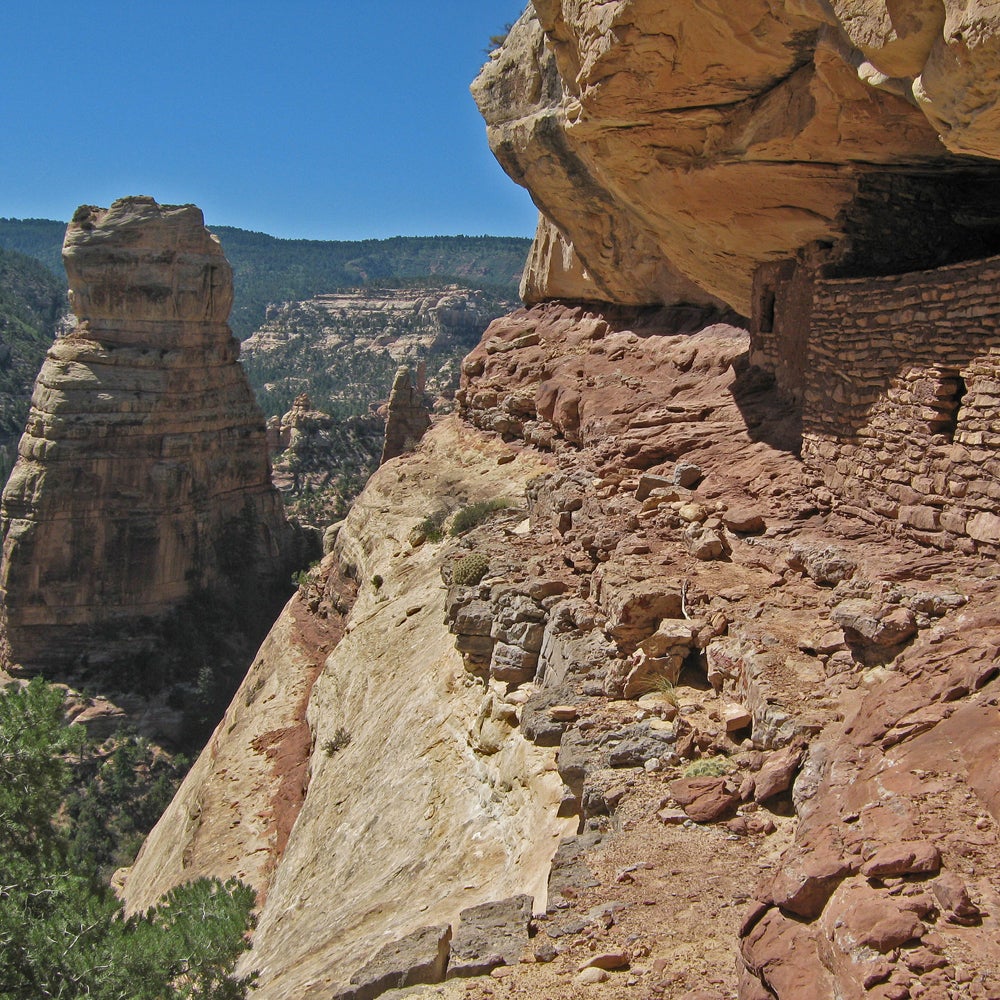Hammond Canyon is a stunning green meadow flanked by white sandstone towers in what, just yesterday, was Bears Ears National Monument. The remote canyon, home of the Three Fingers Ruin, is an archaeological hotspot, but it does not fall within the new Indian Creek or Shash Jáa national monuments, which President Donald Trump created Monday with a disputed use of the Antiquities Act. White Canyon, Valley of the Gods, Grand Gulch, Cheesebox Canyon—pending litigation, these areas all lost protection when Trump sliced nearly 1.15 million acres off Bears Ears.
“You cherish Utah’s gleaming rivers and sweeping valleys. You take inspiration from its majestic peaks, and when you look upon its many winding canyons and glowing vistas, you marvel at the beauty of God’s creation,” Trump told a friendly audience at the Utah state capitol. “And that’s why I’m here today.”
The President then proceeded to sign executive orders opening up such vistas to mineral extraction. His proclamations chopped up Bears Ears, and replaced Grand Staircase-Escalante National Monument with three smaller monuments—Grand Staircase, Escalante Canyon, and Kaiparowits. Combined, the boundaries preserve one million acres, down from 1.9 million that were protected by the original 1996 declaration. Oddly enough, in shrinking Bears Ears, protection of which was instigated by Native American leaders, Trump painted himself as a champion of American Indians.
“We’ve seen how this tragic overreach has prevented many Native Americans from having a voice on their sacred lands, where they practice their most important ancestral and religious traditions,” Trump said. The line elicited applause from the mostly-white audience.
A day prior to Trump’s announcement, I toured Bears Ears and met with Mark Maryboy, who kickstarted push to protect the Bears Ears region when he began surveying tribal elders about sacred sites in 2010. “Total ignorance,” he said of Trump’s approach to the national monument. “No respect for Native tribes, for Native American people across the country.” Jonathan Nez, the Navajo Nation vice president, put it even more simply in a Monday press conference after Trump’s announcement: “What happened today is a slap in the face.”
Maryboy and his Dine Bikeyah team began considering formal protection for the region about eight years ago. Interior Secretary Ryan Zinke came to the decision to shrink Bears Ears after just 45 days. In shrinking the monument, Trump could negate unprecedented tribal collaboration, the first indigenous-led national monument designation, and an expression of tribal sovereignty.
In response, the five nations that supported it will respond in a fashion Utah’s tribes are quite familiar with: Lawsuits.
The creation of Bears Ears was an unprecedented act of diplomacy. When a legislative push failed in 2016, Utah Dine Bikeyah took its proposal to the elected leaders of the Navajo, Ute Mountain Ute, Hopi, Zuni, and Northern Ute tribes to advance the idea to then-President Barack Obama.
“You talk to somebody from another country, it’s complicated,” says Shaun Chapoose, an elected leader of the Northern Ute tribe and member of the Bears Ears Inter-Tribal Coalition. “It’s the same thing when you get this many tribes together. We have histories. Good relationships, not so good relationships. This collaboration should be celebrated.”
The tribes’ historical link to Bears Ears proved powerful enough to overcome those differences. Their, and the desire to save an estimated 100,000 remains, artifacts, and other cultural sites united a diverse coalition of nations. When Obama designated the monument in December 2016, he included a requirement that a tribal advisory group help manage the monument. As a result, Bears Ears garnered support even among tribes that lacked a direct connection to this corner of Utah. Garon Coriz, a doctor from Richfield, Utah, and member of the Santo Domingo Pueblo tribe, grew up hunting in the Bears Ears region, and continues to climb and backpack there. “With Bears Ears … there’s a whole cultural dimension to the landscape. It was acknowledged by the tribes, and fought for by the tribes.”
The lawsuits won’t just seek to clarify the Antiquities Act. They will also serve as a statement of tribal sovereignty and communities flexing greater political influence.
With his Monday proclamation, Trump has followed a consistent pattern in U.S. history: the federal government making a land-management promise to Indians, only to later renege. “I wasn’t surprised,” Chapoose told me in November, shortly after news broke that Trump would modify Bears Ears in some way. “The history of the relationship between the federal government and states and tribes has always been based off of lies, broken promises.”
The role of tribes in creating and managing the monument has been seemingly ignored by both Trump administration officials and Utah politicians. Orrin Hatch, the Utah senator who pushed the Trump Administration to change the monument boundaries, previously said, “The Indians, they don’t fully understand that a lot of the things that they currently take for granted on those lands.” This flies in direct opposition to Obama’s proclamation, which mentions traditional hunting, firewood harvesting, and herb gathering. (The only access curtailed was for future grazing and extraction.) Yet notions of a bureaucratic choke-hold on the land proliferated in Trump’s Monday address.
In fact, the only regulation monument proponents sought was protection for the 100,000 ruins and artifacts in the area——and the ecosystem that sustained those who left the artifacts behind. “There were Anasazi ruins and artifacts all over the place,” says Mary Benally, a Utah Dine Bikeyah board member. “My family said to leave those alone—those are the people who have already been here. Leave it to them.”
Monument opponents have repeatedly been framed as disaffected locals overpowered by the federal government, but that ignores the Navajo residents who advocated for the protections. There’s precedent for this in San Juan County, which is approximately half Navajo. Tribal members, often led by Maryboy, a former county commissioner, have had to file suit over school-district measures, access to ambulances, and other county-provided services. for decades.
To combat Trump’s action, the tribes will do what they’ve been required to do in San Juan County for years. A series of lawsuits filed by tribes, outdoor retailers, and environmental groups in the coming days will argue in federal court that the Antiquities Act doesn’t allow a president to modify national monuments. The lawsuits won’t just seek to clarify the Antiquities Act; to those being represented, they will serve as a statement of tribal sovereignty and communities flexing greater political influence.
“No matter what happened today, history was made,” Chapoose said of Bears Ears. “Five sovereign nations worked together, and saved this land for the benefit of the American people. And that attitude of cooperation will save this monument.”


